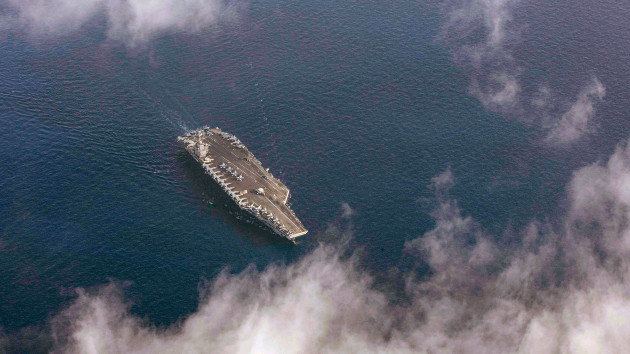(WASHINGTON) — The USS Gerald R. Ford aircraft carrier strike group will leave the eastern Mediterranean Sea, where it was sent just after the start of the Israel-Hamas war in October, in the “coming days,” two U.S. officials tell ABC News.
The Ford is the U.S. Navy’s newest and largest aircraft carrier and was nearing the end of its first operational deployment when it was redirected to the eastern Mediterranean the day after Hamas terrorists launched an unprecedented surprise attack on Israel on Oct. 7.
Defense Secretary Lloyd Austin sent the carrier and the five other surface warships to deter Hezbollah in Lebanon and Iran from broadening the conflict regionally, saying at the time: “As part of our effort to deter hostile actions against Israel or any efforts toward widening this war following Hamas’ attack on Israel.”
In December, Austin extended the carrier’s deployment for a third time to maintain that deterrence role as tensions in the region remained high.
A senior U.S. official and a U.S. official told ABC News that in the “coming days,” the carrier and other surface ships that make up the strike group will return to the carrier’s home port of Norfolk, Virginia, as originally scheduled so it could prepare for future deployments.
The senior U.S. official stressed that the carrier’s return will keep to that schedule and that even with the Ford’s departure, the United States will still have a lot of military capability in the region and flexibility, including the deployment of additional cruisers and destroyers in the Mediterranean and the Middle East.
“We have nothing to announce today,” said a Defense Department spokesman when contacted for comment.
Last week, the amphibious assault ships USS Bataan and USS Carter Hall arrived in the eastern Mediterranean from the Red Sea to reunite with the USS Mesa Verde.
The move reunited the three ships that had originally deployed together in July from North Carolina, as well as the 2,200 U.S. Marines from the 26th Marine Expeditionary Unit (MEU) aboard the ships.
In the wake of Hamas’ Oct. 7 attack, other countries also sent warships to the eastern Mediterranean — creating the largest naval presence in that region in decades — as part of an effort to deter Hezbollah and Iran.
A second U.S. Navy carrier strike group, the USS Dwight D. Eisenhower, had originally been ordered to join the Ford in the eastern Mediterranean but was ordered to the Persian Gulf region to deter Iran from broadening the war between Israel and Hamas.
The Eisenhower remains deployed to the Middle East and is currently in the Gulf of Aden east of Yemen, where tensions have risen in recent weeks as Houthi militants have used drones and ballistic missiles to attack commercial shipping in the Red Sea region, purportedly as a show of support for Hamas.
Several U.S. Navy destroyers from both the Ford and Eisenhower strike groups have been deployed to the Red Sea, where they have brought down Houthi drones and missiles headed either in their direction or toward Israel.
Tensions escalated Sunday as U.S. Navy helicopters returned fire and sank three small boats carrying Houthi militants in the Red Sea, killing the crews, after U.S. warships responded to a distress call from a merchant vessel, military officials said.
Helicopters from the Eisenhower and the destroyer USS Gravely fired in self-defense after being shot at by Houthi militants aboard three fast small boats that were attacking a commercial vessel.
All the militants aboard three boats were killed, and a fourth boat fled, according to a statement from U.S. Central Command.
Copyright © 2024, ABC Audio. All rights reserved.












